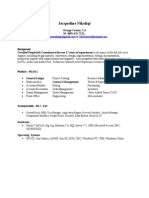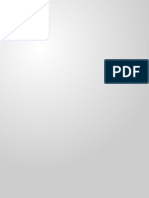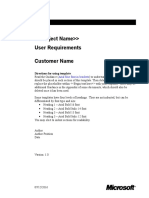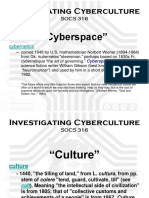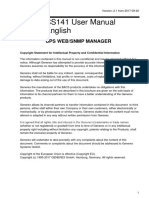User Requirements
User Requirements
Uploaded by
semiariCopyright:
Available Formats
User Requirements
User Requirements
Uploaded by
semiariCopyright
Available Formats
Share this document
Did you find this document useful?
Is this content inappropriate?
Copyright:
Available Formats
User Requirements
User Requirements
Uploaded by
semiariCopyright:
Available Formats
<<Project Name>>
User Requirements
Customer Name
Directions for using template:
Read the Guidance (Arial blue font in brackets) to understand the information that
should be placed in each section of this template. Then delete the Guidance and
replace the placeholder within <<Begin tet here!! with "our response. There ma" be
additional Guidance in the Appendi of some documents# which should also be
deleted once it has been used.
$ome templates ha%e four le%els of headings. The" are not indented# but can be
differentiated b" font t"pe and si&e:
'eading ( ) Arial Bold (* font
'eading + ) Arial Bold ,talic (- font
'eading . ) Arial Bold (. font
'eading . ) Arial Bold ,talic (+ font
/ou ma" elect to indent sections for readabilit".
Author
Author 0osition
1ate
2ersion: (.3
3453+5+3(-
2002 Microsoft Corporation. All rights reserved.
The information contained in this document represents the current view of Microsoft Corporation on the issues
discussed as of the date of publication. Because Microsoft must respond to changing market conditions, it should not
be interpreted to be a commitment on the part of Microsoft, and Microsoft cannot guarantee the accurac of an
information presented after the date of publication.
This document is for informational purposes onl. MICROSOFT MAKES NO WARRANTIES E!PRESS OR
IMP"IE# IN T$IS #OCUMENT%
Microsoft and !isual Basic are either registered trademarks or trademarks of Microsoft in the "nited #tates and$or
other countries.
3453+5+3(-
Revision & Sign-off Sheet
6hange Record
1ate Author 2ersion 6hange Reference
Re%iewers
7ame 2ersion Appro%ed 0osition 1ate
1istribution
7ame 0osition
1ocument 0roperties
,tem 1etails
1ocument Title 8ser Re9uirements
Author
6reation 1ate
:ast 8pdated
3453+5+3(-
Table of Contents
$ummar"..........................................................................................................................
8ser ;perience...............................................................................................................
;ase of 8se......................................................................................................................
Reliabilit"........................................................................................................................
0erformance....................................................................................................................-
<ulti=language Re9uirements........................................................................................-
Accessibilit"...................................................................................................................-
;nd=8ser Training Re9uirements...................................................................................-
3453+5+3(-
%Intro&uction to t'e Tem()ate
#escri(tion* The "ser &e'uirements document defines the non(functional aspect of
the user)s interaction with the solution. *t provides guidance on the user interface,
e+pectations of the solution)s performance, reliabilit, and accessibilit, and defines
what must be done in order to properl train the users on the solution.
+usti,ication* A successful solution satisfies both the organi,ation)s need for
technolog and the user)s e+pectations for emploing that technolog. #trong, e+plicit
user re'uirements facilitate the development and deliver of a solution that users
consider an asset to their organi,ational activities.
-Team Ro)e Primar-* Pro.ram Mana.ement is responsible for ensuring that the
user re'uirements document is completed in a timel manner. #e/e)o(ment has the
primar responsibilit for creating the content of the user re'uirements document.
User E0(erience is responsible for ensuring that all relevant user roles and user
perspectives and needs are identified.
Team Ro)e Secon&ar-* Pro&uct Mana.ement will review and understand the user
re'uirements document in order to conve those to parties e+ternal to the team and
to ensure that user re'uirements are represented according to initial pro.ect sponsor
re'uirements. Test will review the user re'uirements to ensure test plans are in place
to validate the re'uirements. Re)ease Mana.ement will review the document to
ensure operational, deploment, migration, interoperabilit and support needs are
addressed./0
3453+5+3(- (
Summar-
%#escri(tion* 1rovide an overall summar of the contents of this document. This
should include the criteria b which the user re'uirements were established and how
the were validated.
+usti,ication* #ome pro.ect participants ma need to know onl the document)s
highlights, and summari,ing creates that user view. *t also enables the full reader to
know the essence of the document before the e+amine the details.0
<<Begin tet here!!
User E0(erience
%#escri(tion* The "ser 2+perience section lists and defines the user e+perience
re'uirements. This includes a description of the elements of the current user
e+perience that are acceptable for the new solution and what elements need to
change to surpass the current user e+perience. This section ma also define the
processes that will collect feedback from the user communit regarding how well the
re'uirements were implemented.
+usti,ication* This information supports the approach that puts the user, rather than
the technolog, at the center of the process. 3athering user concerns and
e+pectations promotes the principle that the users) needs should be foremost in an
design decisions.0
<<Begin tet here!!
Ease o, Use
%#escri(tion* The 2nd of "se section defines the users) abilit to emplo the solution
without an negative impact on their primar work responsibilities. 2ase of use
re'uirements ma include a definition of the solution)s flow$navigation and interface
design 4simplicit, alignment with other solutions alread in place, intuitive, etc5. This
section ma also define the processes that will collect feedback from the user
communit regarding how well the re'uirements were implemented.
+usti,ication* This information supports the approach that puts the user, rather than
the technolog, at the center of the process. 3athering user concerns and
e+pectations promotes the principle that the users) needs should be foremost in an
design decisions.0
<<Begin tet here!!
Re)ia1i)it-
%#escri(tion* The &eliabilit section describes the users) e+pectations on how
reliable the solution must be. This information ma be stated at both the solution level
as well as the feature level. This section ma also define the processes that will
collect feedback from the user communit regarding how well the re'uirements were
implemented.
3453+5+3(- +
+usti,ication6 &eliabilit e+pectations from the users are from their business
perspective ( what the solution must deliver to ensure their productivit. This is
important information that will lead to designing a solution that is stable and
trustworth in its operational environment.0
<<Begin tet here!!
Per,ormance
%#escri(tion* The 1erformance section describes the users) e+pectations on the
solution)s performance, usuall described as application response time. This
information ma be stated at both the solution level as well as the feature level. This
section ma also define the processes that will collect feedback from the user
communit regarding how well the re'uirements were implemented.
+usti,ication6 1erformance e+pectations from the users are from their business
perspective ( what the solution must deliver to ensure their productivit. This is
important information that will lead to designing a solution that is stable and
trustworth in its operational environment.0
<<Begin tet here!!
Mu)ti2)an.ua.e Requirements
%#escri(tion* The Multi(7anguage &e'uirements section identifies an international
support that the solution must address.
+usti,ication* "nderstanding these re'uirements earl will enable the development
team to design all international support features into the solution and ensure that the
entire scope of users is accommodated.0
<<Begin tet here!!
Accessi1i)it-
%#escri(tion* The Accessibilit section identifies the handicap$accessibilit
re'uirements that the solution must meet. 2+amples of these are support for multiple
hardware input tpes, support for e+isting operating sstem accessibilit features,
etc.
+usti,ication* "nderstanding these re'uirements earl will enable the development
team to design all support features into the solution and ensure that the entire scope
of users is accommodated.0
<<Begin tet here!!
En&2User Trainin. Requirements
%#escri(tion* The 2nd("ser Training &e'uirements section defines the training
re'uirements that must be met prior to the solution)s production deploment. This
information does not identif specific training events or mediums 4that information is
3453+5+3(- .
in the Training 1lan5. Training re'uirements define the competencies that the users
must have in order to emplo the solution successfull and identifies where users do
not currentl have those competencies. The gap between the needed competenc
and the e+isting competenc becomes the training re'uirements.
+usti,ication* The Training 1lan is created based on the training re'uirements.0
<<Begin tet here!!
3453+5+3(- -
You might also like
- PTE Academic: Online Practice Test and Mock Test of PTE TestDocument3 pagesPTE Academic: Online Practice Test and Mock Test of PTE TestFourModules50% (2)
- CV Notes PDFDocument206 pagesCV Notes PDFthomasNo ratings yet
- Bell ColliderDocument7 pagesBell ColliderTuro Villalba100% (1)
- Dynamic Oracle Performance Analytics: Using Normalized Metrics to Improve Database SpeedFrom EverandDynamic Oracle Performance Analytics: Using Normalized Metrics to Improve Database SpeedNo ratings yet
- End-User Support PlanDocument8 pagesEnd-User Support PlansemiariNo ratings yet
- Deployment PlanDocument13 pagesDeployment PlansemiariNo ratings yet
- Migration PlanDocument12 pagesMigration PlanSreenivas RaoNo ratings yet
- SRS Online TollDocument8 pagesSRS Online TollSuraj Tikhe0% (1)
- TOGAF 9 Template - Architecture Contract With Business UsersDocument10 pagesTOGAF 9 Template - Architecture Contract With Business Userspiero_zidaneNo ratings yet
- Supermarket Management System: in TR Odu CT Io NDocument38 pagesSupermarket Management System: in TR Odu CT Io NNandha Kumar100% (5)
- Deployment PlanDocument13 pagesDeployment PlansemiariNo ratings yet
- Sap Co PDFDocument313 pagesSap Co PDFSanjeev KumarNo ratings yet
- Operations Plan Customer Name: Directions For Using TemplateDocument12 pagesOperations Plan Customer Name: Directions For Using TemplatesemiariNo ratings yet
- Migration Plan Customer Name: Directions For Using TemplateDocument9 pagesMigration Plan Customer Name: Directions For Using TemplatesemiariNo ratings yet
- Security Plan Customer Name: Directions For Using TemplateDocument24 pagesSecurity Plan Customer Name: Directions For Using Templatesemiari100% (1)
- System Requirements Customer Name: Directions For Using TemplateDocument6 pagesSystem Requirements Customer Name: Directions For Using TemplatesemiariNo ratings yet
- Monitoring Plan Customer Name: Directions For Using TemplateDocument10 pagesMonitoring Plan Customer Name: Directions For Using TemplatesemiariNo ratings yet
- Vision (Small Project) : AuthorsDocument7 pagesVision (Small Project) : AuthorsCally CalinNo ratings yet
- Master Project Plan 0.2Document9 pagesMaster Project Plan 0.2semiariNo ratings yet
- Communications Plan Customer Name: Directions For Using TemplateDocument7 pagesCommunications Plan Customer Name: Directions For Using TemplatesemiariNo ratings yet
- Business Vision Khoi TaDocument8 pagesBusiness Vision Khoi TaLePhongNo ratings yet
- Milestone Review Report Customer Name: Directions For Using TemplateDocument8 pagesMilestone Review Report Customer Name: Directions For Using TemplatesemiariNo ratings yet
- Project Requirements Template 2Document9 pagesProject Requirements Template 2Monica TheothersideofThrough JohnsonNo ratings yet
- Software Requirements Specification: VersionDocument13 pagesSoftware Requirements Specification: Versionsachinsonu15No ratings yet
- Development Plan Customer Name: Directions For Using TemplateDocument12 pagesDevelopment Plan Customer Name: Directions For Using TemplatesemiariNo ratings yet
- Requirements Specification TemplateDocument14 pagesRequirements Specification TemplatePriyanka HaldarNo ratings yet
- All in One TemplateDocument14 pagesAll in One TemplatePedrollo VsNo ratings yet
- Jacqueline NikoliqiDocument9 pagesJacqueline NikoliqinatassidogNo ratings yet
- Vision/Scope Customer Name: Directions For Using TemplateDocument11 pagesVision/Scope Customer Name: Directions For Using TemplatesemiariNo ratings yet
- Resume (Venkat Adira)Document45 pagesResume (Venkat Adira)Mohamed AbrarNo ratings yet
- Software Requirement SpecificationDocument7 pagesSoftware Requirement SpecificationprasanthrajsNo ratings yet
- Online Blood Donation Management System Report - FinalDocument80 pagesOnline Blood Donation Management System Report - FinalguruannamalaiNo ratings yet
- Review and Test PlanDocument15 pagesReview and Test PlanchidseymattNo ratings yet
- EJFF38 Full Journal DefinitionDocument1,052 pagesEJFF38 Full Journal Definitionsergei5555No ratings yet
- Software Requirements SpecificationDocument21 pagesSoftware Requirements SpecificationBikash KarnNo ratings yet
- Sap AuditDocument12 pagesSap AuditVino BrilloNo ratings yet
- Software Development Plan TemplateDocument6 pagesSoftware Development Plan TemplatePrasetyo Survive TryNo ratings yet
- Efficient Claim SysDocument63 pagesEfficient Claim SysLalitha NaiduNo ratings yet
- 1.1 Control Module RequirementsDocument70 pages1.1 Control Module RequirementsShivani Ekant YadavNo ratings yet
- Budget Plan Customer Name: Directions For Using TemplateDocument10 pagesBudget Plan Customer Name: Directions For Using TemplatesemiariNo ratings yet
- Performance Analyzer: Submitted byDocument107 pagesPerformance Analyzer: Submitted byDiwakar VishwakarmaNo ratings yet
- Online Blood Donation Management System ReportDocument116 pagesOnline Blood Donation Management System ReportYogesh Tonpe78% (9)
- 1.1 Project Description: Modules Involved in The Project: Students ModuleDocument51 pages1.1 Project Description: Modules Involved in The Project: Students ModulemanikmathiNo ratings yet
- Communication Plan TemplateDocument10 pagesCommunication Plan TemplateMirza Moazzam BaigNo ratings yet
- Vision and ScopeDocument7 pagesVision and ScopeHalitSendenizNo ratings yet
- Payment Billing System DocumentDocument71 pagesPayment Billing System DocumentParveen KumarNo ratings yet
- Q1) What Is The % of BA in Team Size and Project Duration?Document13 pagesQ1) What Is The % of BA in Team Size and Project Duration?SURAJ RATHODNo ratings yet
- 1.1. Software Development Plan - SP Ramos - OswaldoDocument10 pages1.1. Software Development Plan - SP Ramos - OswaldoJonnel Vasquez SilvaNo ratings yet
- Service Catalogue TemplateDocument16 pagesService Catalogue TemplateRaffa BernardiNo ratings yet
- Prod59 PreDocument14 pagesProd59 PreARINDAM SETTNo ratings yet
- Activity Management SystemDocument5 pagesActivity Management SystemGaus PatelNo ratings yet
- Project Management Group Assignment: Scope Statement & Report For Technology Associates, IncDocument11 pagesProject Management Group Assignment: Scope Statement & Report For Technology Associates, IncMuhammad AwaisNo ratings yet
- CMS SRSDocument13 pagesCMS SRSMohd ImranNo ratings yet
- Chapter - 1Document69 pagesChapter - 1manikmathiNo ratings yet
- Executive Summary: U.S. House of Representatives Systems Development Life-Cycle PolicyDocument45 pagesExecutive Summary: U.S. House of Representatives Systems Development Life-Cycle PolicycasualityontopNo ratings yet
- CH 01Document9 pagesCH 01Abdul KarimNo ratings yet
- Introduction To Group Policy in Windows Server 2003: Microsoft Corporation Published: April 2003Document19 pagesIntroduction To Group Policy in Windows Server 2003: Microsoft Corporation Published: April 2003jimmytownNo ratings yet
- TOGAF 9 Template - Implementation Governance ModelDocument7 pagesTOGAF 9 Template - Implementation Governance Modelpiero_zidaneNo ratings yet
- User Requirements Customer Name: Directions For Using TemplateDocument8 pagesUser Requirements Customer Name: Directions For Using TemplatearupkboseNo ratings yet
- SystemVerilog for Hardware Description: RTL Design and VerificationFrom EverandSystemVerilog for Hardware Description: RTL Design and VerificationNo ratings yet
- Business Dashboards: A Visual Catalog for Design and DeploymentFrom EverandBusiness Dashboards: A Visual Catalog for Design and DeploymentRating: 4 out of 5 stars4/5 (1)
- Engineering Documentation Control / Configuration Management Standards ManualFrom EverandEngineering Documentation Control / Configuration Management Standards ManualNo ratings yet
- InduSoft Application Design and SCADA Deployment Recommendations for Industrial Control System SecurityFrom EverandInduSoft Application Design and SCADA Deployment Recommendations for Industrial Control System SecurityNo ratings yet
- Bank Pasargad Multi Payment: Technical Specification 1.2 1392Document22 pagesBank Pasargad Multi Payment: Technical Specification 1.2 1392semiariNo ratings yet
- Monitoring Plan Customer Name: Directions For Using TemplateDocument10 pagesMonitoring Plan Customer Name: Directions For Using TemplatesemiariNo ratings yet
- Master Project Plan 0.2Document9 pagesMaster Project Plan 0.2semiariNo ratings yet
- Budget Plan Customer Name: Directions For Using TemplateDocument10 pagesBudget Plan Customer Name: Directions For Using TemplatesemiariNo ratings yet
- Project Name Focus Area: Feature NameDocument3 pagesProject Name Focus Area: Feature NamesemiariNo ratings yet
- Development Plan Customer Name: Directions For Using TemplateDocument12 pagesDevelopment Plan Customer Name: Directions For Using TemplatesemiariNo ratings yet
- Communications Plan Customer Name: Directions For Using TemplateDocument7 pagesCommunications Plan Customer Name: Directions For Using TemplatesemiariNo ratings yet
- Milestone Review Report Customer Name: Directions For Using TemplateDocument8 pagesMilestone Review Report Customer Name: Directions For Using TemplatesemiariNo ratings yet
- Vision/Scope Customer Name: Directions For Using TemplateDocument11 pagesVision/Scope Customer Name: Directions For Using TemplatesemiariNo ratings yet
- MSF For Cmmi Process Improvement v5 Process GuidanceDocument68 pagesMSF For Cmmi Process Improvement v5 Process GuidancesemiariNo ratings yet
- MFC Demo ScriptDocument1 pageMFC Demo ScriptsemiariNo ratings yet
- PI ControllerDocument5 pagesPI Controllerdanuega1No ratings yet
- Open-Assistant (Admin.) Level 4Document3 pagesOpen-Assistant (Admin.) Level 4Shyam ShahNo ratings yet
- 2-Tier and 3-Tier Client/Server SystemsDocument4 pages2-Tier and 3-Tier Client/Server Systemsyasmeen_shabana100% (1)
- Before You BeginDocument5 pagesBefore You BeginJobert RamirezNo ratings yet
- SmartStream Designer Configurators For Enfocus Switch - CA394-13690Document4 pagesSmartStream Designer Configurators For Enfocus Switch - CA394-13690pedroaraoztNo ratings yet
- Sinumerik840D Mill en GDocument252 pagesSinumerik840D Mill en Gphungminhtoan2477No ratings yet
- Muhammad Rifqi Fatahillah - Teknik InformatikaDocument1 pageMuhammad Rifqi Fatahillah - Teknik Informatikarifqi fNo ratings yet
- SQLDocument29 pagesSQLsamalparthaNo ratings yet
- Cps 303 NoteDocument40 pagesCps 303 NoteHABIBUNo ratings yet
- Total Station ProcedureDocument10 pagesTotal Station ProcedureCatherine CortezNo ratings yet
- OpenHardwareMonitor ReportDocument9 pagesOpenHardwareMonitor ReportpalosotNo ratings yet
- A Brief History of The InternetDocument10 pagesA Brief History of The InternetMark Lester Paredes LorenzoNo ratings yet
- 01-Sap HCM Paper1 (Q&A)Document16 pages01-Sap HCM Paper1 (Q&A)Anonymous Y1csGYNo ratings yet
- RST 2602 PDFDocument48 pagesRST 2602 PDFhulikul22No ratings yet
- Introduction To IDL PDFDocument3 pagesIntroduction To IDL PDFAbdelkrim BouasriaNo ratings yet
- Transliteration PDFDocument6 pagesTransliteration PDFKami ChemistNo ratings yet
- Toolkit ReferenceDocument581 pagesToolkit ReferenceMarcio BulhoesNo ratings yet
- Ro'a JDocument2 pagesRo'a JAbdoAbuzantNo ratings yet
- VibracionesDocument99 pagesVibracionesValeria CDNo ratings yet
- The Customers Will Be Able To Search For The Different Flower Bouquet Shops That Are Available Near To Their Places So That They Will Be Able To Order OnlineDocument6 pagesThe Customers Will Be Able To Search For The Different Flower Bouquet Shops That Are Available Near To Their Places So That They Will Be Able To Order Onlinesuriya extazeeNo ratings yet
- Timber DesignDocument3 pagesTimber DesignAJ17% (6)
- Manual SNMP UPS Legrand PDFDocument28 pagesManual SNMP UPS Legrand PDFBRAIANNo ratings yet
- Day-2 Aggregate FunctionsDocument25 pagesDay-2 Aggregate FunctionsAshok DuraiNo ratings yet
- Difference Between Top Down and Bottom Up DesignDocument2 pagesDifference Between Top Down and Bottom Up DesignJijin Rs100% (1)
- Nav 2013 Installation Configuration PDFDocument386 pagesNav 2013 Installation Configuration PDFWilfresh KhafadhiNo ratings yet
- Network Critical PhyDocument17 pagesNetwork Critical Phy(unknown)No ratings yet


























